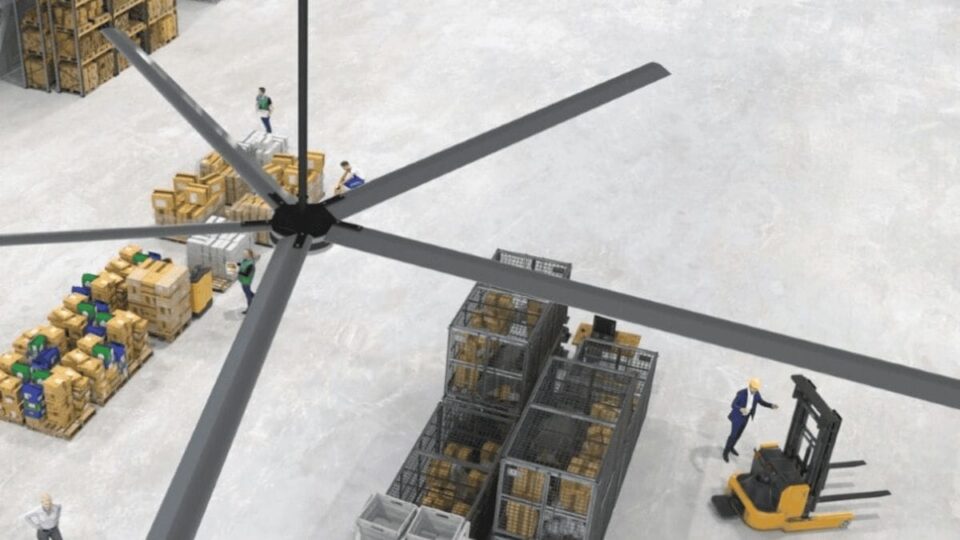Maintaining the comfortable temperature and airflow in large, open facilities has always been a top priority for industrial workplaces. SafeWork guidelines recommend keeping the temperature between 20-26 degrees for most tasks, but lower temperatures are necessary for activities that involve higher physical exertion. However, achieving and sustaining such ideal temperatures becomes challenging, especially with the rising temperatures in Australia.
Plant managers have adopted various approaches, such as installing advanced heating, ventilation and air cooling (HVAC) systems to combat the heat. Additionally, to improve efficiency, they utilise traditional floor or ceiling fans as standalone equipment or as a supplement to the HVAC system. One popular option is the use of high-volume, low-speed (HVLS) fans that efficiently circulate air, significantly enhancing worker comfort and even extending the lifespan of the HVAC system in the process.
HVAC for industrial ventilation
HVAC, an abbreviation for heating, ventilation, and air Conditioning, encompasses a diverse range of cooling and heating systems to regulate the indoor climate and enhance air quality within buildings. It plays a crucial role in creating a comfortable and healthy environment in both commercial and industrial settings.
To elevate the indoor temperatures, the HVAC system components include furnaces, boilers, heat pumps, and electric resistance heaters and then distribute the resulting heat throughout the building using ductwork or radiators. When it comes to cooling industrial indoor spaces during hot weather, the methods include central air conditioning systems, ductless mini-split systems, and window units.
Efficiently moving air with HVAC systems can be a challenge in today’s industrial buildings. From deteriorating duct systems to leaks in ceilings and windows, numerous obstacles hinder the effectiveness of traditional air movement systems. To overcome these challenges, it becomes common to integrate HVAC systems with HVLS fans for air movement.
HVLS fans for industrial ventilation
HVLS, which stands for High-volume Low-speed fans, are the ultimate solution for efficient and quiet cooling in large spaces. With a diameter greater than seven feet, these ceiling-mounted fans create a powerful column of air that cascades down and spreads horizontally. This process, known as evaporative cooling, is what makes us feel cooler in a breeze. In contrast, during the winter, when the warm air accumulates on the ceiling while cold air falls, making it cooler near the floor level, HVLS fans push the warm air back down and mixing it with the cooler air, ensuring that the temperature is evenly distributed across the entire space, creating a comfortable environment for everyone.
Originally designed for agricultural settings to cool livestock, HVLS fans have found their way into various commercial and industrial settings such as warehouses, manufacturing facilities, shopping centres and gyms, as these fans are low-speed and deliver efficient cooling without disturbing noise levels.

Combining HVAC and HVLS fans for optimal cooling
Maintaining a comfortable environment in an industrial facility is crucial for productivity and worker well-being, especially during summer months when high temperatures can lead to fatigue, errors, and distractions. HVAC systems efficiently provide cooled air, but they don’t optimise airflow. HVLS ceiling fans alleviate this issue by effectively circulating air, reducing the burden on the system, saving energy and creating a cooling effect together.
Looking for HVLS fans?
At Fanquip we have a range of HVLS fans, also known as a Giant Industrial Fans, to deliver unmatched air movement efficiency across a wide range of applications such as workshops, production areas, and animal holding sheds. In addition, these fans can enhance the performance of your facility’s existing HVAC system. Get in touch with our team to receive personalised recommendations on the ideal fan model that suits your workplace perfectly.
Check out our range Industrial Fans & Warehouse Cooling Solutions.
